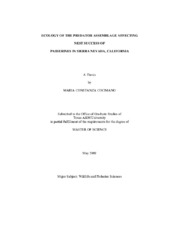| dc.description.abstract | The endangered willow flycatcher (Empidonax traillii) breeds in mountain
meadows in the Sierra Nevada, which have been intensively modified, especially
reducing meadow wetness, which favors easy access for mammalian predators to reach
nesting areas in the meadow interior. High nest predation frequency is one of the main
factors for willow flycatcher and other passerines? populations decline. I conducted
trapping in wet and dry areas on 10 meadows in May?August of 2007 and 2008 to
identify the assemblage of potential mammalian nest predators. I compared the predator
activity between wet and dry areas of the meadows and determined the relationship
between predator activity with vegetation and hydrology of the meadows. In 2008, I
used radio-telemetry on deer mice (Peromyscus maniculatus) and yellow-pine
chipmunks (Tamias amoenus) to determine their movement patterns across wet and dry
areas, and between forest and meadow. My results showed that chipmunks? and
squirrels? activity was restricted almost to dry areas. The activity of yellow-pine
chipmunks was 96% and 97% higher in dry versus wet areas in 2007 and 2008,
respectively. Voles, mice, and shrews were active in both site types. Voles (Microtus spp.) and shrews (Sorex spp.) were in general more active in wet areas versus dry areas
in 2007. Deer mice were equally active in both site types in 2007 and more active in wet
areas in 2008. Between years, predators were 68% more active in wet areas in 2007
compared to 2008, and similarly 52% more active in dry areas. Radio-tagged deer mice
used the forest and the meadow and were more common in dry areas, whereas yellowpine
chipmunks used more the forest than the meadows and were active only in dry
areas. Passerines nesting in drier areas are exposed to a larger assemblage of potential
predators and are more likely to be predated. My results suggest that increasing the
proportion of inundated areas in the meadows would help reduce predator activity
(especially chipmunks and squirrels) and consequently nest predation, helping increase
flycatcher numbers. In addition, wetter conditions will favor an increment in food
availability for flycatchers and an increment in willow cover, which consequently will
provide more nesting substrate and will help increase nest concealment. | en |


